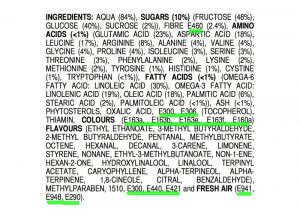E numbers and INS numbers
E numbers and INS numbers are used to identify food additives that are used in the preparation and processing of food products. These codes provide a standardized way to label additives and allow consumers to be informed about what substances are present in the food they are consuming.
E numbers are codes for substances used as food additives, including those found naturally in many foods. The E number system is a European-based naming system for food additives. (Source: https://www.copperpodip.com/post/introduction-to-international-numbering-system-ins-for-food-additives)
The International Numbering System for Food Additives (INS) is another naming system for food additives. (Source: https://en.wikipedia.org/wiki/International_Numbering_System_for_Food_Additives)
The INS is defined by Codex Alimentarius, the international food standards organization of the World Health Organization (WHO) and the Food and Agriculture Organization (FAO) of the United Nations (UN). INS numbers consist of three or four digits, optionally followed by an alphabetical suffix to further characterize individual additives.
On packaging in the European Union (EU), approved food additives are written with a prefix of E. An additive that appears in the INS does not automatically have a corresponding E number but it is a general trend that the INS numbers correspond to E numbers for the same compound12. (Source: https://www.copperpodip.com/post/introduction-to-international-numbering-system-ins-for-food-additives)
E numbers
E numbers are a system of codes used within the European Union (EU) to identify food additives. The “E” stands for “Europe” and these numbers were established by the European Food Safety Authority (EFSA) and the European Commission.
The E number system was introduced to harmonize the use of food additives across the EU member states and to ensure that only safe and approved additives are used in food products.
Food additives with E numbers include preservatives, antioxidants, flavor enhancers, colorings, emulsifiers, stabilizers, thickeners, and more.
The list of E numbers and their permitted uses is defined in the EU Regulation (EC) No 1333/2008, which specifies the types and maximum levels of additives that can be used in various food categories.
Here is a list of E numbers and their categories:
- E100–E199 (colours)
- E200–E299 (preservatives)
- E300–E399 (antioxidants, acidity regulators)
- E400–E499 (thickeners, stabilisers, emulsifiers)
- E500–E599 (acidity regulators, anti-caking agents)
- E600–E699 (flavour enhancer)
- E700–E799 (antibiotics).
Image Source: Mirror friendly (the healthy life)
INS Numbers
INS numbers, which stand for “International Numbering System,” are used by the Codex Alimentarius Commission. The Codex Alimentarius is a joint program of the Food and Agriculture Organization (FAO) and the World Health Organization (WHO), established to develop food standards, guidelines, and related texts.
The INS numbering system was created to provide a global standard for identifying food additives, ensuring consistency in labeling worldwide.
Similar to E numbers, INS numbers represent different food additives with specific roles in food processing and preparation.
- 0–199 (colours)
- 200–299 (preservatives)
- 300–399 (antioxidants, acidity regulators)
- 400–499 (thickeners, stabilisers, emulsifiers)
- 500–599 (acidity regulators, anti-caking agents)
- 600–699 (flavour enhancer)
- 700–799 (antibiotics)
Role and Usage
Both E numbers and INS numbers serve the same purpose of identifying food additives used in various food products.
Food additives play important roles in food processing, such as extending shelf life, enhancing flavors, improving texture, and maintaining product stability and appearance.
When food manufacturers use additives, they are required to list them on the product label, usually accompanied by their corresponding E number or INS number, depending on the region of sale.
The INS system is primarily used in India and is not as widely recognized as the E number system. Therefore, food manufacturers in India use both the E number system and the INS system to label their products. This is why both E numbers and INS numbers are mentioned on food wrappers.
Products and Usage
Food additives are found in a wide range of products, including processed foods, beverages, baked goods, dairy products, candies, snacks, and more.
The INS numbering system, developed by the Codex Alimentarius Commission, provides a standardized way to identify food additives and is commonly used in many countries, including India. Food additives in India are labelled with INS numbers, and these numbers are regulated and approved by the Food Safety and Standards Authority of India (FSSAI).
It’s possible that some imported products or products specifically manufactured for export may carry E numbers for compliance with international labeling standards. In such cases, the E numbers might be visible on the packaging for products intended for markets outside India.
However, for products meant for the domestic Indian market, the primary and official system for labeling food additives is the INS numbering system.
Please note that food regulations and practices may change over time, so it’s always a good idea to refer to the latest guidelines and regulations issued by FSSAI or other relevant authorities in India for the most up-to-date information.
An additive that appears in the INS does not automatically have a corresponding E number. INS numbers are assigned by the committee to identify each food additive. INS numbers generally correspond to E numbers for the same compound, e.g. INS 102, Tartrazine, is also E102 (Source: https://en.wikipedia.org/wiki/International_Numbering_System_for_Food_Additives)
The Indian food industry has adopted the INS system for food additives. However, the use of E numbers is still prevalent in India. The reason for this is that the E number system is widely recognized and used globally. The INS system is not as widely recognized as the E number system and is used primarily in India. Therefore, food manufacturers in India use both the E number system and the INS system to label their products.
In conclusion, E numbers and INS numbers are standardized systems used to identify food additives worldwide. While E numbers are mandatory in the EU, other regions may use them voluntarily or adopt the INS numbering system. These codes are used on food labels to inform consumers about the presence of specific additives and help ensure the safety and regulatory compliance of food products.


